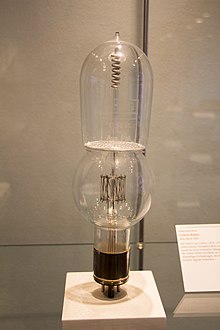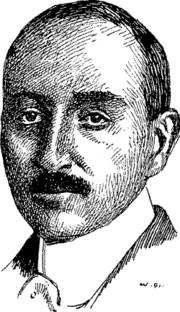Robert of loves
Robert von Lieben (born September 5, 1878 in Vienna ; † February 20, 1913 there ) was an Austrian physicist . He invented the Lieben tube , the first electron tube with an amplifier effect , which not only enabled the German long-distance telephone network to be established from 1912, but also formed the basis for numerous future inventions that were intended to amplify electrical signals .
Life
Robert was the son of Leopold von Lieben, President of the Vienna Stock Exchange Chamber and Anna von Lieben from the family of the barons von Todesco . He grew up in Oppolzergasse 6 in Vienna, attended the Academic Gymnasium , then a Realschule at the Schottenbastei in Vienna, but did not finish with the Matura .
Thanks to wealthy parents, he was able to pursue his scientific inclinations, for example he set up the electric lighting in his father's villa in Hinterbrühl .
After school he went to Schuckert & Co. in Nuremberg as a volunteer . He then volunteered for the military, but after a few weeks suffered a riding accident from which he never fully recovered. After a time as a guest student at the University of Vienna, he went to the Institute for Physical Chemistry at the University of Göttingen , headed by Walther Nernst , for a year , where he did not, however, obtain a degree. Back in Vienna, he set up a laboratory. In 1904 he bought a telephone factory in Olomouc , which he soon sold again.
Von Lieben applied for his first patent in 1906. The " cathode ray relay " made it possible for the first time to amplify electrical signals such as B. Tone frequencies on one line. In the same year, the American inventor Lee de Forest registered a patent for a similar invention - the Audion tube , now known as the triode . After an additional patent to improve his invention, von Lieben finally took up de Forest's triode in his third patent from 1910 in order to realize further improvements with it that he did not achieve with his own invention. The fact that von Lieben was able to use de Forest's patent to improve his own invention was due to the fact that de Forest had only made patent claims on the circuit as an audion , which von Lieben took advantage of. The fact that the inventions of the two, which apparently had the same goal of amplifying transmitted signals, differed significantly and therefore also had different patent claims in the patent text, was again due to the fact that Lieben had more of an amplifier effect for telephone traffic in mind while de Forest dealt with wireless telegraphy and, associated with it, with improving the sensitivity of radio reception . That led to years of litigation.
In 1911 von Lieben married Anny Schindler , an actress at the Vienna Burgtheater . In 1913 Robert von Lieben died at the age of 34 after a serious illness. It is now resting in the Döblinger Friedhof in Vienna. In 1928 Liebenstrasse in Vienna- Meidling was named after the inventor.
Inventions

His concern with the invention of an electrochemical phonograph and the polarization of X-rays (1903) as well as the purchase of a telephone factory in 1904 prompted him to grapple with the problem of amplification of the transmitted signals, which was still unsolved at the time. This led to the application of his first and most important patent on March 4, 1906, that of the cathode ray relay - a telephone amplifier ("telephone relay") that works by controlling a cathode ray ( electron beam ) by a magnetic field. In the patent text, he describes how “by means of current fluctuations of small energy those of higher energy are triggered”, “whereby the frequency and curve shape of the triggered current fluctuations correspond to those of the triggering one. [...] In particular for some telephony problems (transmission of speech over long distances, cable telephony, wireless telephony, amplification of speech and music transmission, etc.) the use of this relay can be advantageous. To achieve this purpose, the property of glowing metal oxides found by Wehnelt is used to emit cathode rays in a vacuum as cathodes at relatively low potentials (around 200 volts). "
On March 30, 1910, von Lieben, together with Eugen Reiss and Siegmund Strauss , applied for a patent for a “ relay for undulating currents ”. This essentially represented an improvement of the first patent. The patent specification saw possible areas of application for this relay “ as a sound amplifier, as a relay in wire and cable telegraphy in local and long-distance traffic, as well as in wave telegraphy and telephony, and also as an auxiliary device for the telegraph and for electrical image transmission, etc. "
On December 7, 1910, he submitted his third patent, the so-called "grid patent" - again together with Reiß and Strauss. It was another additional patent that allows for better proportional gain. Since his attempts in this regard with his cathode ray relay were unsuccessful, he took up the invention of Lee de Forests , who in 1906 invented his Audion tube , now known as the triode , which is comparable to the cathode ray relay . Building on this triode, which differed from the cathode ray relay by an additional, grid-like, auxiliary electrode, it was able to achieve a proportional gain, which de Forest had not been able to achieve before. This advantage over the Forest tube ultimately led Telefunken to opt for the Lieben tube, buy up its patents and take over the further expansion.
However, this triode, which von Lieben improved, still had a problem: The residual mercury vapor gases led to disruptive ionization effects . The high vacuum could not be mastered technologically until 1913. Due to further experiments on the Liebenröhre in Germany, the connection to the high vacuum technology was initially missed, but already the first successor tubes were based on the structure of the American tubes. From 1914/15 it was also possible to control the high vacuum in Germany.
On July 13, 1911, Lieben's fourth patent followed - again together with Reiss and Strauss. It was intended to increase the service life, uniformity and economy of its relay.
literature
- Dear Robert. In: Austrian Biographical Lexicon 1815–1950 (ÖBL). Volume 5, Verlag der Österreichischen Akademie der Wissenschaften, Vienna 1972, p. 193.
- Goetzeler, Herbert: Robert von Lieben. In: New German Biography (NDB). Volume 14, Duncker & Humblot, Berlin 1985, ISBN 3-428-00195-8 , p. 474 f. ( Digitized version ).
- Pichler, Franz: Robert von Lieben: 100 years patent cathode ray relay , Linz: Trauner, 2006. (Series of publications History of Natural Sciences and Technology; Vol. 7) ISBN 3-85487-943-1
- Quirin Engasser (ed.): Great men of world history. 1000 biographies in words and pictures . Neuer Kaiser Verlag, Klagenfurt 1987, ISBN 3-7043-3065-5 , p. 271
Web links
- Literature by and about Robert von Lieben in the catalog of the German National Library
- Entry on Robert von Lieben in the Austria Forum (in the AEIOU Austria Lexicon )
- Biography of Robert von Lieben, with a description of his most important patents
- Commissioning of a love tube and recording of the characteristic curve
- 100 years of amplifier tube heise.de
- cm: 102 year old amplifier tube in operation. heise online , January 13, 2015, accessed on January 13, 2015 .
Individual evidence
- ↑ knerger.de: The grave of Robert von Lieben
- ↑ Patent No. 179807 of March 4, 1906 (PDF; 151 kB) - "Cathode ray relay"
- ↑ Patent No. 236716 of September 4, 1910 (PDF; 198 kB) - "Relay for undulating currents, in which an ionizer is influenced by the current fluctuations to be amplified"
- ↑ Patent No. 249142 of December 20, 1910 (PDF; 383 kB) - "Relay for undulating currents - addition to patent 236716 of September 4, 1910"
- ^ Wilhelm Formann: Austrian pioneers of cinematography. Bergland Verlag, Vienna 1966, pp. 47–50
- ↑ Patent No. 254588 of July 13, 1911 (PDF; 177 kB) - "Process for increasing the service life, uniformity and economy of discharge tubes with glowing cathodes"
| personal data | |
|---|---|
| SURNAME | Dear, Robert von |
| BRIEF DESCRIPTION | Austrian physicist |
| DATE OF BIRTH | September 5, 1878 |
| PLACE OF BIRTH | Vienna |
| DATE OF DEATH | February 20, 1913 |
| Place of death | Vienna |


